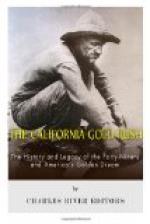The immediate cause was the cynical and open criminal activity of an Englishman named James Stuart. This man was a degenerate criminal of the worst type, who came into a temporary glory through what he considered the happy circumstances of the time. Arrested for one of his crimes, he seemed to anticipate the usual very good prospects of escaping all penalties. There had been dozens of exactly similar incidents, but this one proved to be the spark to ignite a long gathering pile of kindling. One hundred and eighty-four of the wealthiest and most prominent men of the city formed themselves into a secret Committee of Vigilance. As is usual when anything of importance is to be done, the busiest men of the community were summoned and put to work. Strangely enough, the first trial under this Committee of Vigilance resulted also in a divided jury. The mob of eight thousand or more people who had gathered to see justice done by others than the appointed court finally though grumblingly acquiesced. The prisoners were turned over to the regular authorities, and were eventually convicted and sentenced.
So far from being warned by this popular demonstration, the criminal offenders grew bolder than ever. The second great fire, in May, 1851, was commonly believed to be the work of incendiaries. Patience ceased to be a virtue. The time for resolute repression of crime had arrived. In June the Vigilance Committee was formally organized. Our old and picturesque friend Sam Brannan was deeply concerned. In matters of initiative for the public good, especially where a limelight was concealed in the wing, Brannan was an able and efficient citizen. Headquarters were chosen and a formal organization was perfected. The Monumental Fire Engine Company bell was to be tolled as a summons for the Committee to meet.




